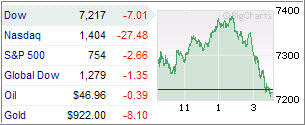
Reader Mike pointed to “Dent, Napier and Prechter—Wise to Heed Their Predictions.” If you have not heard any wild predictions lately, you’re in luck. Take a look at some of the highlights:
Harry S. Dent Jr., the author of ‘The Roaring 2000s’, ‘The Roaring 2000’s Investor’, ‘The Next Great Bubble Boom’ and his latest book entitled ‘The Great Depression Ahead’ states that
“The most important cycle change for your wealth, health, life, family, business, and investments is just ahead during the first and last depression you are likely to experience in your lifetime.”
Dent makes it clear that his predictions, while almost always contrary to most economists and expectations, have almost always proved to be correct because his predictions are based on the same sound and quantifiable logic insurance actuaries use with a high degree of accuracy to predict, decades in advance, when people will die.
With that understanding of the basis for his forecasting he goes on to predict (and I paraphrase) that:
Dow will Rebound to 10,000 – 13,200 within 6 Months
A likely massive stimulus plan will bolster the economy somewhat into 2009 for a likely rebound in the Dow to between 10,000 and 13,200. A projected bullish scenario puts the Dow between 12,000 and 13,200 between April and September 2009 if the Treasury rescue plan takes hold with the markets anticipating a recovery. A projected bearish scenario assumes that if the recovery is at best rocky, or at worst that we were to move more into a depression in 2009 than a serious recession, that the Dow would only get back to 10,000 to 11,000 and not last as long.
Oil will Increase to $180 – $215+ by 2010 and then Decline to $40 – $60 by 2015
Oil prices will likely rise to a commodity bubble peak of between $180 and $215, possibly even more, and if not that high then, at an absolute minimum, retest its 2008 high of $147, between late 2009 and mid-2010 unless the economy implodes earlier in 2009. We should then see a major crash in oil prices, beginning in 2010, back into the $40 – $60 range, and possibly even lower, between 2012 and 2015 which will continue for years.
Commodities will Peak between 2009 and mid-2010
Commodities in general, including gold and other precious metals despite their crisis hedge qualities in the past, will likely peak between mid- to late 2009 and mid-2010. It will probably be 2020 or 2023 before we see the next sustained commodity boom and bubble which should last into 2039 – 2040.
Dow will Fall to 3,800 – 4,500 by 2012
The next accelerated stock crash, led by emerging markets, Asian stocks, financial stocks and tech stocks – and finally by oil and commodity stocks – will likely occur between mid- to late 2009 and late 2010, when most of the damage will occur, and continue off and on into mid- to late 2012. The Dow will fall at least to 4,500 and more likely as low as 3,800 by mid-2012, the 1994 low where the stock market bubble first began.
Nasdaq will Fall Below 1,100, its 2002 low, by late 2010 or mid-2012 at the latest.
Market will Rally from 2012 until 2017
A substantial bear market rally will likely occur between around mid-2012 and early to mid-2017 and then a less severe downturn will occur from around mid-2017 into early 2020 or as late as early 2023.
Economy will be in a Depression by 2011
The worst of this next depression is likely to hit between mid-2010 and mid-2013, especially around early 2011, but if the banking system continues to implode a deep downturn or depression could begin sometime in 2009 instead of 2010.
This is just a small sample of the predictions featured in this article. As always, while these may be well researched conclusions, I sure would not bank on any of these events happening within the time frame specified.
If in fact a substantial rally materializes first before the bottom drops out and the Dow falls into the 4,000 range by 2012, it will present a repeat disaster for all of those continuing to buy and hold as they’re hanging on for dear life hoping that a bear market rally is the real thing.
My take is that if any of these predictions are somewhat close, they will present tremendous opportunities for those who are willing to unemotionally follow trends and, at the same time, are disciplined enough to get out when trends end. It bears repeating: Investment discipline is the tool that will guide you through these treacherous conditions.





